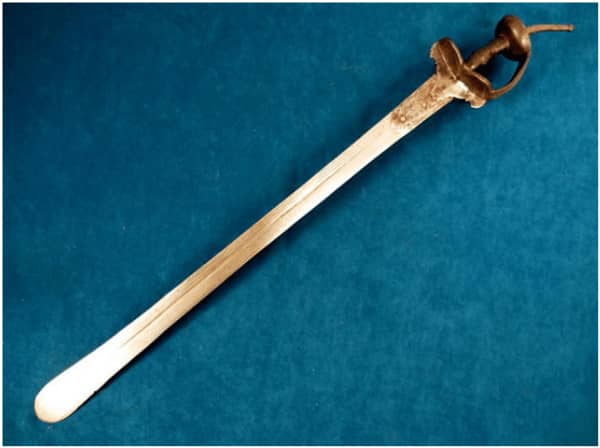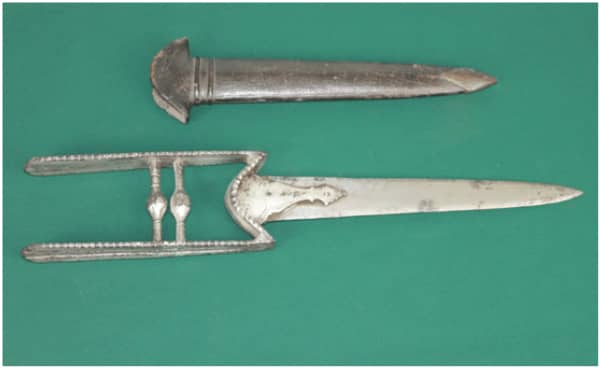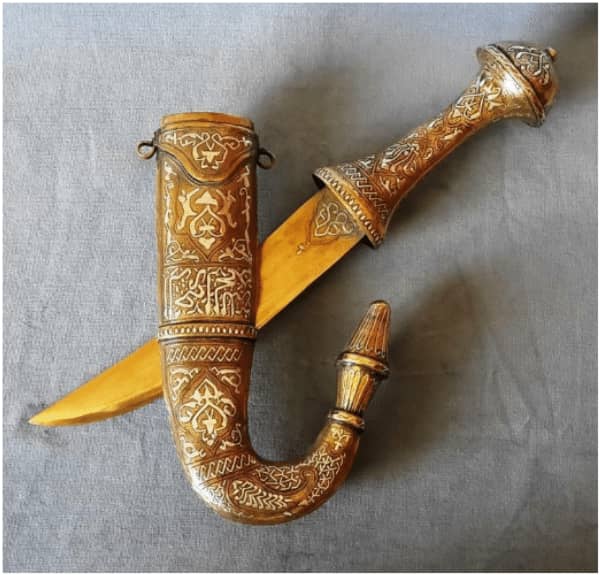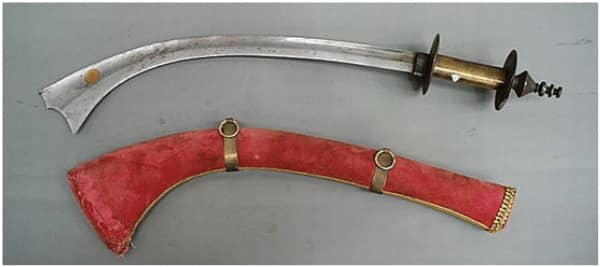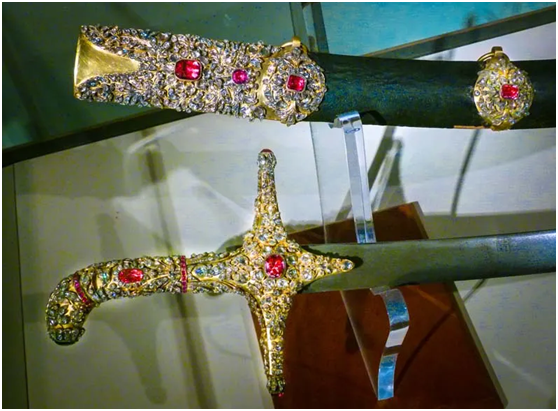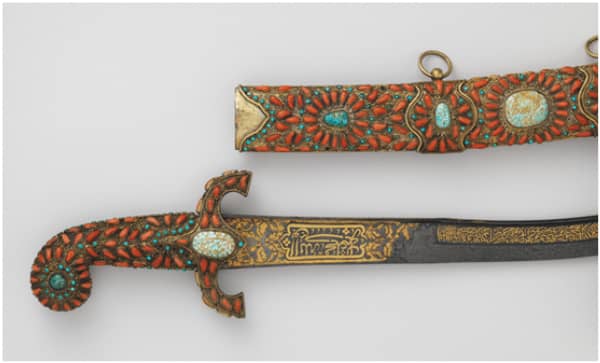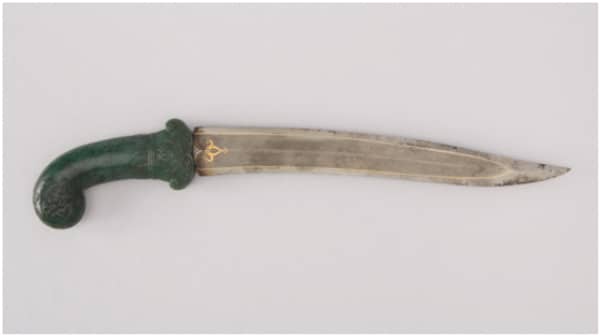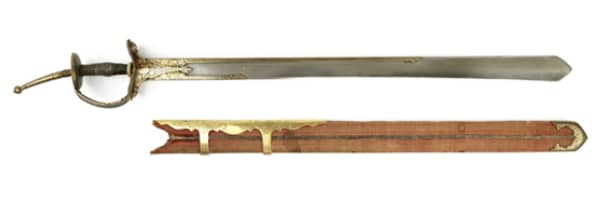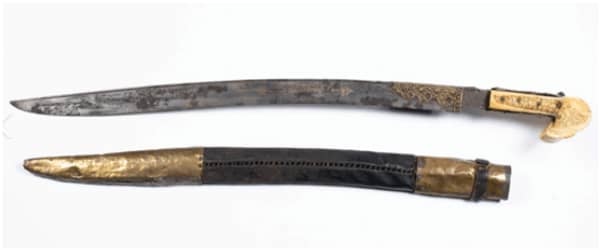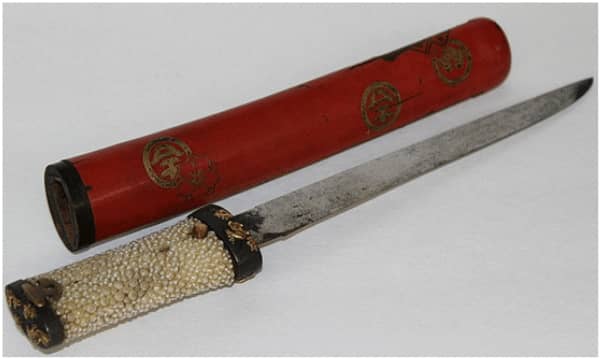The raw materials and ingredients of the ancient weapons of the Islamic nations include iron, copper, steel, gold, silver, jade, coral and other various decorative accessories.
This classification is briefly described as follows:
01 iron
The ancient Indians used to forge and smelt iron extensively in ancient times. From 1000 to 2000, the straight iron swords used by the people of South India and Nepal, the double-edged sword body, the guard and the handle are made of a single piece of iron. There is also an iron sword with a curved wide blade and no guard. The blade and handle are also cast from a single piece of iron, and the round cake shape at the end of the handle is also similar to the Chinese Zhou sword. Similar objects have also been found in Persia and the Caucasus and elsewhere.
▲The Indian Khanda sword is quite similar to ancient Chinese swords. Its blade and handle are also forged from a single piece of iron
02 steel
Most of the ancient steel swords in India are also made of a single piece of steel to form a single handle, especially the Katar dagger. The Guke Taer sword in South India has a very large handle and is exquisitely carved. It is often made into various strange animal shapes, just like the decoration on the Chinese embroidered Luan knife. The hilt and the upper part of the blade of this kind of sword are engraved with raised convex patterns, which shows the essence of ancient Indian ironwork. India’s steel cold weapons have followed the habits of Persia and other Islamic nations for thousands of years. Most of them are inlaid with gold and silver. No fingers get in the way. There are also those with gold and silver bases and copper decorations on them, but they are relatively rare. The second series is inlaid with gold or silver wire and beaten into the small grooves of the blade and handle to form various patterns and inscriptions (most of them are rhymes in the Islamic classic “Quran”, the name of the holder, the year and the maker of the blade. name), is a second-class thing.
▲The Indian Kertar sword with a whole piece of Uzi steel cast into a blade and handle
03 Copper
The Islamic peoples used copper knives in ancient times, which are displayed in various museums in Europe, and they are also made of a whole piece of copper with a handle and blade. He then used carved copper as the handle, and then used copper blocks and copper pieces to insert into the handle and used copper as the sheath. Nowadays, the Islamic nations of Egypt, Arabia, and Turkey still like to use bronze weapons.
▲Arabian copper Gabia scimitar with copper handle and copper sheath
04 black steel
Islamic nations also use black iron or black steel as weapons, most of which are inlaid with small silver pieces to custom black and white shine. Or wrap the upper part of the blade, handle and sheath with silver wire to custom a horizontal pattern decoration. Burmese, Ceylonians, Malays, Turks, and Egyptians all like to use such weapons. The Muslim blacks around the Red Sea also had similar but relatively crude weapons.
05 gold
Persia, India, Turkey, Egypt, Caucasus and other nations like to inlay their armor, knives, swords, axes, hammers and other weapons with gold sheets and gold wires to make various flowers, birds, figures and inscriptions. Indian princes and Malay chiefs also like to use gold as the handle of their swords, and the richest ones use gold as the sheath and are decorated with precious stones. The Nepalese Kora knife is also carved with gold as a handle. The Caucasians are very fond of inlaying weapons with gold thread. Their guns, blades, and sheaths are all inlaid with gold thread. Sometimes the steel pipes or gun barrels of Caucasus ancient guns are inlaid with gold threads all over the body, which looks like a gold tube. The Caucasian long knife also has a gold handle and is wound with gold wire. As for whether the eastern peoples used gold as blades, axes, or hammers in ancient times, there is no real thing, and no one has heard of it.
▲Nepal’s gold-handled Kola sword
06 gems, pearls
All Islamic nations like to inlay their weapons with various gemstones to show the splendor and brilliance of the owner and the luxury of the owner and the preciousness of the weapon. Although good blades do not need to rely on decorations, Islamic weapons with rich decorations have good blades. This is also due to the habit. There are also differences among them.
▲Islamic scimitars used by Persian princes and nobles are decorated with rubies, diamonds and sapphires
For example, the Persians like to use enamel or ivory to custom handles and sheaths, and they pay attention to inlaying natural turquoise. This kind of jade is often used to inlay armor, swords and saddle reins, etc., sometimes with rubies and green diamonds. Afghans and Bukharas also like to decorate weapons with large and small sapphires and turquoises. Although Indians also paid attention to handles and sheaths made of enamel, they prefer to use white jade and jasper instead of ivory, and Rubies, Emerald and diamonds instead of turquoise. The rooms are also decorated with pearls, but they are in the minority. It is not like the rich Malays like to use pearls as weapon ornaments.
Turks, modern Egyptians, and Arabs like to use red corals. They cut the corals into so-called teardrop-shaped long melon seeds, and inlaid them on the top of the blade, the handle, and the sheath, or on the ancient guns, or in the shape of round flowers. Thought jewelry. Turks like to use clam pieces as decoration, juxtaposed with coral. The Caucasian uses a black mosaic enamel handle and sheath on a silver background. The above various decorations quite show the differences in martial arts and customs of the oriental Islamic peoples. It can also be used to know why the nation’s ancient weapons.
▲Turkish Islamic style scimitar is cut into a teardrop shape with red coral and inlaid with a scabbard handle
07 Jade
The ancient Islamic weapon decorations use the most jade, and the Indian nation is the first. Kanjar, the small sword of the Indian princes and nobles, uses white jade as the handle and the sheath is decorated with six or seven out of ten; Its long swords and long knives also use jade as handles. Most of the jade handles are carved in the shape of a lotus flower or horse head and inlaid with red and emerald stones as decoration.
▲Indian jasper handle Kancha sword
08 Crystal
Islamic people also like to use crystal as the handle to inlay red and emerald gemstones. Local people in Sindh, India like to use glass to custom fake crystal handles, or use fake crystal chips to embed hammers, knives and other utensils. Other Islamic peoples also like to use crystal handles.
09 Timber
The handles of hammers and axes of the Islamic nation are all made of wood and covered with leather or velvet, and then decorated with silver or copper pieces. Even the sheath of the sword is made of two pieces of solid wood, most of which are chestnut trees. The two pieces of wood are not glued or nailed together, but are covered with gold, silver, copper, leather, velvet, cloth, etc., and the wood pieces are hidden inside to hold the blade. cloth only. There are also those who use wood as the handle. For example, the Kukri knife in Nepal mostly uses ebony or yellow wood as the handle, with or without silver leather. The Kancha and Kama swords used by the Caucasus often use ebony as the I-shaped handle. The Burmese and Malays widely use mahogany wood as the handle and sheath with bamboo as the auxiliary.
10 Paints
Except for Chinese and Japanese cold weapons that like to use lacquer, other oriental peoples don’t like lacquer very much, especially the Islamic people. However, among the Khanta long swords or long knives of India, there are also several places in the middle of the blade painted with red paint. The Kola broadswords used by the Nepalese for sacrifices are also mostly painted with lacquer. Islamic nations such as Egypt, Sudan, Arabia, and Ethiopia often like to paint the blade body, handle, and sheath with red, green, black, and white paints to make round stars or geometric corner pieces and lined with copper rings to fake enamel. Burmese and Malays also occasionally use lacquer to protect their handles and scabbards.
▲The hilt of Khanta long sword in India is decorated with red lacquer
11 Tortoiseshells
Hawksbill is a kind of large turtle shell, which has two colors of black and yellow. It is rare for Islamic peoples to decorate their weapons with tortoiseshell, but the aborigines of Ceylon like to use large tortoiseshell tortoise shells as knife handles and carve them into Buddha statues or animal shapes. Malay hunting knives also use tortoiseshell as handles. When firearms were first introduced, the oriental people used the original small tortoise shell inlaid with silver as gunpowder pots, but it was rare.
12 Paper slime
The Punjabi people in India once pounded paper into mud shields and painted the surface with lacquer to make them firm, slippery and light.
13 Leather
The Persians like to use black leather to hammer the reverse side into a convex pattern on the front, which is the outer sheath of their long knives and short swords. Bow sheaths, quivers, and gunpowder pots are also embroidered with flower skins. The belts and quivers of Indian long swords and knives are also embroidered to increase their color. The most famous skin is called Shagreen or Chagrin, which is the back skin of an animal, and its color is dark blue and close to black. Indians also like to use hippopotamus skin, elephant skin and Sampar animal skin as their shields. In the Gejie Kach place, the leather is first boiled to make it transparent, and then painted with gold to paint it. Sometimes, the sentences in the “Koran” are used as inscriptions, or red, sapphire and gold threads are inlaid.
The Yataghan, the Yataghan knife of the Turks, has a silver sheath for the noble ones, and a black leather sheath with embossed patterns for the common ones. The same is true for the long knives, and sometimes a small leather belt is hung beside the sheath. Caucasian long swords with ivory handles and sheaths wear very narrow long leather belts, and ordinary knives also use black leather sheaths. Egyptians and Sudanese like to use crocodile skins and snakes to decorate handles and sheaths, and sometimes red skins as sheaths; many of the long powder pots used by camel warriors are made entirely of leather. Most of the Japanese knives are made of sharkskin with a wooden handle and sheath, and they are called “Same”.
▲The Turk’s Yatkan knife is paired with a gold foreskin and black leather sheath
▲ Japanese armor with a leather handle
14 Fleece
The ancient axes, hammers and other weapons of the Islamic peoples often wrap their handles with flannelette of various colors. Knives and swords are wrapped in their sheaths, either in red, or in green, or in purple, crimson, or in blue, or cyan, and there are also those with red on one side and green on the other (Indian Kanda long knives often have this kind bi-color sheath). The velvet cloth is embroidered, inlaid with gold and silver thread strips, or covered with gold, silver, small copper sleeves and rings on the top and bottom.
Bow burdens, quivers, gunpowder pots and bullet bags are also often wrapped in flannelette. The embossed velvet cloth with copper nails is the middle Jazerant, and sometimes it is combined with leather to make body armor or saddles and other utensils. Afghans like to use purple velvet for their scabbards. Turks like to use dark velvet or red velvet for the sheath decoration of Yakankan broadsword and Bichak knife. Indians like to use red and green velvet for all kinds of knives and scabbards. Egyptians like to use red velvet.
15 Toba
This one is black egret named Kalghi. Indian Sikhs warriors like to use this long black feather to decorate their helmets and military caps. This feather is very rare and expensive, because there is only one long feather on the wing of a black egret. Its feathers are attached to the helmet with gold or silver wire. The second is peacock feathers. All ethnic groups in Islam, especially in India, often regard the peacock as the god of war or the holy bird. The warriors of the Indian Rajputs Raipoots like to decorate their crowns with peacock feathers. Feathers were also placed on the helmets of ancient Persian warriors. The helmets of the Turkish and Mongols also have small tubes for inserting feathers.
Click to have more Shieldon knives and tools manufacturers.

